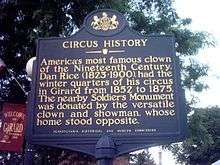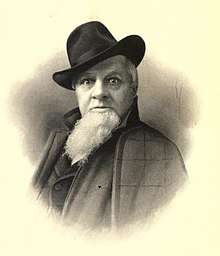Dan Rice
Dan Rice (January 23, 1823 – February 22, 1900) was an American entertainer of many talents, most famously as a clown, who was pre-eminent before the American Civil War. During the height of his career, Rice was a household name. Dan Rice was also an innovator, as he coined the terms "One Horse Show" and "Greatest Show" whilst becoming the pacesetter for the popularization of the barrel-style "French" cuff. He was a leading personality in the new American "pop culture", brought on by the technological changes of the Industrial Revolution and resultant mass culture.[1] Rice became so popular he ran for President of the United States in 1868.[1] With changes in circus venues and popular culture after the Civil War, his legendary talents under the big top have gradually slipped into almost total historical obscurity such that in 2001, biographer David Carlyon called him "the most famous man you've never heard of".[1]
Biography

Born Daniel McLaren in New York City, Rice gained 19th century fame with many talents, most of which involved him gallivanting around as a clown figure in circuses. In addition to his 'clowning' talents, he was an animal trainer, songwriter, commentator, political humorist, strong man, actor, director, producer, dancer, and politician. He ran for Senate, Congress, and President of the United States — dropping out of each race.[1]
Rice changed the circus into what it is today by combining animals, acrobats and clowns.[1] His first break came in 1841, when he got a job of presenting a pig named Sybil who could do many tricks, including the ability to tell time.[1] From there he moved on to singing and dancing, and got caught up briefly in the popularity of the 'negro song', singing in blackface.[2] Gaining fame and popularity, he changed styles once again; he starred in various parodies of works by William Shakespeare, including that of "Dan Rice's Version of Othello" and "Dan Rice's Multifarious Account of Shakespeare's Hamlet". He would perform these with various songs and dialects. "Rice was not simply funnier than other clowns; he was different, mingling jokes, solemn thoughts, civic observations, and songs."[1] During the 1847-48 season he was working with the circus of Gilbert R. Spalding.[3]
Expanding his horizons, he went into producing his own shows, and often had more than one tour going on at the same time. He wanted to move on from his frivolous clowning, and reinvented himself into a gentleman. He started to take up politics and would often have Democratic undertones in his shows.[1] He was then regarded as not only a multi-talented performer, but a smart and noble man who was to be admired. He won the affection of many newspapers and publicists, including those of a then unknown Mark Twain and Walt Whitman.[1] Mark Twain paid him homage in his description of a circus in Adventures of Huckleberry Finn, and it is likely a boyhood Twain actually saw Rice perform when his circus came to Hannibal for a show.[1]
His shows became more famous than any of the other shows touring at the time, including that of rival, Phineas Taylor Barnum.[1] During the 19th century, his name was synonymous with theater. He reinvented the theater into a vaudevillian style before there was vaudeville. He was very patriotic, later influencing the likes of George M. Cohan. He was also one of the main models for "Uncle Sam".[1] He died almost penniless in 1900 and is buried in the Old First Methodist Church cemetery in West Long Branch, New Jersey.
His fame is still celebrated to this day. The small town of Girard, Pennsylvania has a three-day festival dedicated to Dan Rice called "Dan Rice Days". He had a home in Girard and lived there for many years.
Expressions

A number of popular expressions came into being around Dan Rice.[1]
- Rice campaigned for Zachary Taylor as president, inviting him to campaign on the circus bandwagon, whence the expression "to jump on the bandwagon".
- Early in his career, Rice was down on his luck and only had one horse (in early circuses the core show was a horse show). His competitors mocked him, saying it was a "one horse show" as a derogatory. Rice was able to turn the expression around by putting on a good show, and it became famously attached to him for the rest of his life.
- The rallying cry of "Hey, Rube!" - later transformed into a noun - originated in New Orleans in 1848 when a member of Rice's troupe was attacked by a mob and he yelled to his friend Reuben, "Hey, Rube!". The phrase is most commonly known today in the circus world as a "Hey, Rube" meaning "come help in this fight".
- Decades before other circuses used the phrase, an Arkansas paper praised Rice's as "The Greatest Show on Earth."
See also
Footnotes
- David Carlyon. Dan Rice: The Most Famous Man You've Never Heard Of
- Emerson, Ken (1998). Doo - Dah. New York: Da Capo. pp. 101–102. ISBN 0-306-80852-8.
- William L. Slout, Olympians of the Sawdust Circle: A Biographical Dictionary of the 19th-Century American Circus, The Borgo Press (1998) - Google Books p. 281
References and further reading
| Wikimedia Commons has media related to Dan Rice. |
- Carlyon, David (2001). Dan Rice: The Most Famous Man You've Never Heard Of. Persus Books Group. ISBN 1-891620-57-6.
- The Life of Dan Rice, by Maria Ward Brown, 1901. via Internet Archive (scanned book, illustrated)
- Domowicz, Geoffrey L; Girard: A Canal Town History; Arcadia Publishing
- "Civil War's Most Famous Clown", New York Times, September 18, 2014